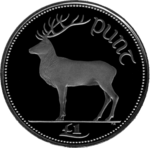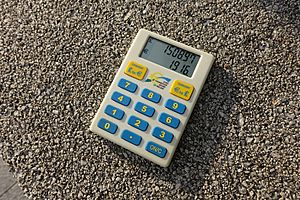Irish pound facts for kids
Quick facts for kids Irish pound |
|||
|---|---|---|---|
|
|||
| ISO 4217 Code | IEP | ||
| User(s) | None, previously: |
||
| ERM | |||
| Since | 13 March 1979 | ||
| Fixed rate since | 31 December 1998 | ||
| Replaced by €, non cash | 1 January 1999 | ||
| Replaced by €, cash | 1 March 2002 | ||
| € = | £0.787564 (irrevocable) | ||
| Subunit | |||
| 1⁄100 | penny (English) pingin (Irish) |
||
| Symbol | £ | ||
| penny (English) pingin (Irish) |
p | ||
| Nickname | quid | ||
| Plural | pounds (English) puint, punta (Irish) |
||
| penny (English) pingin (Irish) |
pence (English) pinginí, pingineacha (Irish) |
||
| Coins | |||
| Freq. used | 1p, 2p, 5p, 10p, 20p, 50p, £1 | ||
| Banknotes | |||
| Freq. used | £5, £10, £20 | ||
| Rarely used | £50, £100 | ||
| Printer | Currency Centre of the Central Bank of Ireland | ||
The pound (called punt in Irish) was the official money of the Republic of Ireland until 2002. Its special code was IEP, and its symbol was £. Sometimes, people added "Ir" to the symbol (like £Ir) to show it was the Irish pound. The Irish pound was replaced by the euro on January 1, 1999. However, euro coins and notes didn't start being used until early 2002.
Contents
History of the Irish Pound
The First Irish Pound
The first Irish coins were made in the late 900s. Back then, one pound was divided into twenty shillings, and each shilling had twelve silver pence. This was known as the £sd system (pounds, shillings, pence).
Around 1210, King John made the Irish pound worth the same as the British pound. This helped silver move easily between Ireland and England. But from 1460, Irish coins had a different amount of silver, so their value became different from English coins.
In 1701, the value of the Irish pound was officially set: 13 Irish pounds were worth 12 British pounds. This meant that Irish copper coins could be used alongside English silver coins.
In 1801, the Kingdom of Ireland joined the United Kingdom. The Irish pound continued to be used until January 1826. After 1826, the Irish pound was combined with the British pound sterling. Some Irish banks still printed paper money, but it was in sterling. No new Irish coins were made until the Irish Free State was formed in the 20th century.
The Second Irish Pound
The Free State Pound
After gaining independence in 1922, the new Irish Free State (called Saorstát Éireann in Irish) started using its own money in 1928. This new Free State pound was designed to be worth exactly the same as the British pound sterling. This meant that one Irish pound was always equal to one British pound.
Just like the British system, the Irish Free State used the £sd system:
- Pound (punt in Irish)
- Shilling (scilling in Irish)
- Penny (pingin in Irish)
New coins and banknotes were introduced. The first coins came out in 1928. These included coins for a quarter penny, halfpenny, penny, threepence, sixpence, shilling, florin (two shillings), and half crown (two shillings and sixpence). In 1966, a special ten shilling coin was made, but it wasn't meant for everyday use.
Most Irish coins were the same size as their British versions, except for the threepence and sixpence. Irish coins were often thicker and made of nickel, while British ones were thinner and made of silver. British money was usually accepted in Ireland, but Irish money was not always accepted in the United Kingdom, except in parts of Northern Ireland.
The Irish Pound Name Change
On December 29, 1937, the country's name officially changed to "Ireland" (Éire in Irish). On May 10, 1938, the currency's name officially became the Irish pound.
Decimalisation
In the 1960s, Ireland decided to change its money system to a decimal system, just like Britain. This meant that instead of shillings and pence, the pound would be divided into 100 "new pence."
The Decimal Currency Act of 1969 made this change happen. The pound itself didn't change value, so banknotes stayed the same. However, the ten shilling note was replaced by a 50p coin. New coins were made that were the same size and material as the new British decimal coins. For example, the new 5p coin was like the old shilling, and the new 10p coin was like the old florin.
The change to decimal currency happened on Decimal Day, February 15, 1971.
Breaking the Link with Sterling
In the 1970s, the European Monetary System was created. Ireland decided to join it in 1978, but the United Kingdom did not.
This decision finally broke the direct link between the Irish pound and the British pound sterling. From March 30, 1979, the value of the Irish pound was no longer fixed to the British pound; it could change based on the market.
Around this time, in 1978, the Currency Centre was built in Sandyford. This meant that Ireland could print its own banknotes and make its own coins within the country. Before this, British companies printed Irish banknotes and made the coins.
1979–1999: Free-Floating Currency
Until 1986, all Irish decimal coins were the same shape and size as their British equivalents. But after that, new Irish coins or redesigned ones were made in different sizes. For example, the new 20p coin (introduced in 1986) and the £1 coin (introduced in 1990) were very different from the British versions.
When the UK made its 5p and 10p coins smaller, Ireland also made theirs smaller. However, the new Irish 10p was smaller than the new UK 10p, and the new Irish 5p was slightly larger than the UK 5p. The Irish 50p coin was never made smaller, unlike the British 50p.
Even though British sterling coins were not official money in Ireland, people often accepted British 1p, 2p, and 5p coins because they were similar in size.
Replacement with the Euro
On December 31, 1998, the exchange rate between the Irish pound and the new European Currency Unit (which became the euro) was officially set. The fixed rate was: 1 euro = 0.787564 Irish pounds. This meant that one Irish pound was worth about 1.27 euros. The Irish pound was the only currency among the first group joining the euro that was worth more than one euro.
The euro became the official money for countries in the eurozone (including Ireland) on January 1, 1999. But it wasn't until January 1, 2002, that Irish pound coins and notes were taken out of circulation and replaced with euro coins and notes. Other eurozone countries did the same.
Irish pound coins and notes stopped being official money on February 9, 2002. However, you can still exchange all Irish coins and banknotes (from the time of the Irish Free State onwards) for euros at Ireland's Central Bank in Dublin.
See also
- Banknotes of the Republic of Ireland
- Coins of the Republic of Ireland
- Commemorative coins of Ireland
- Irish euro coins
- Economy of the Republic of Ireland



